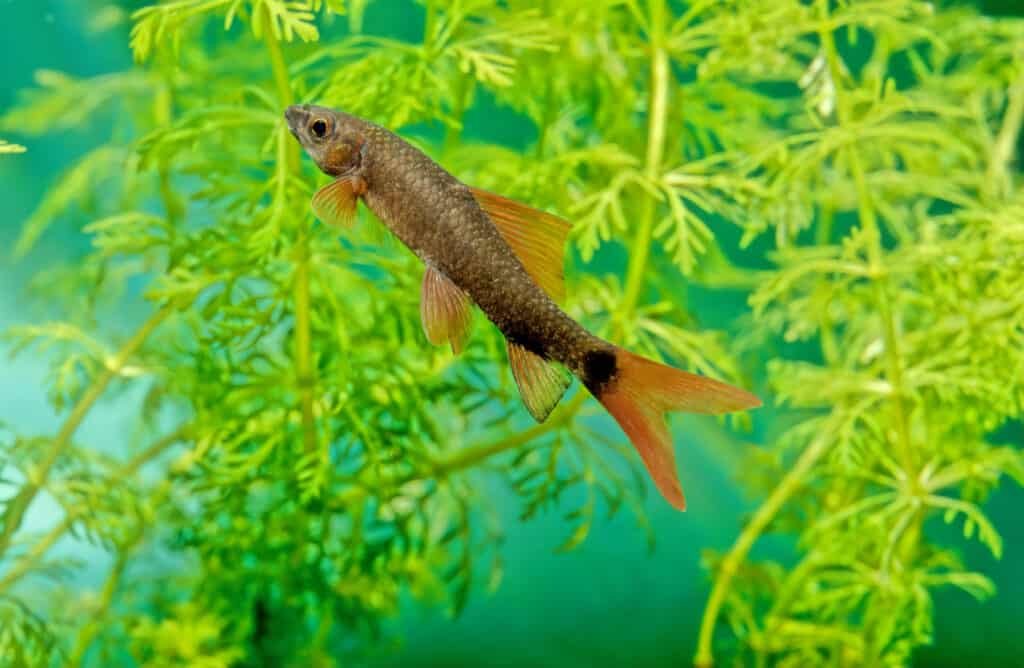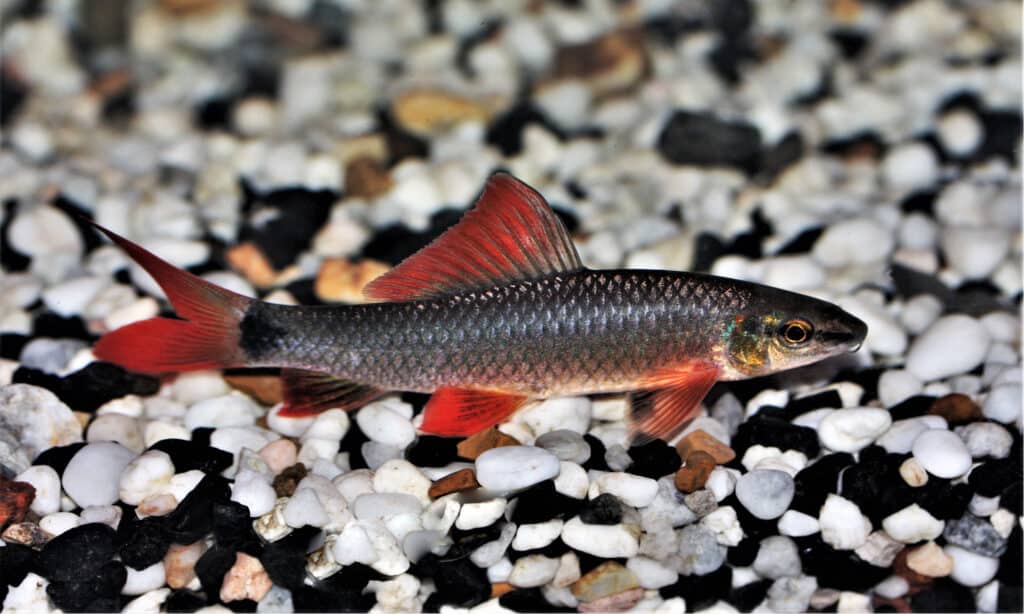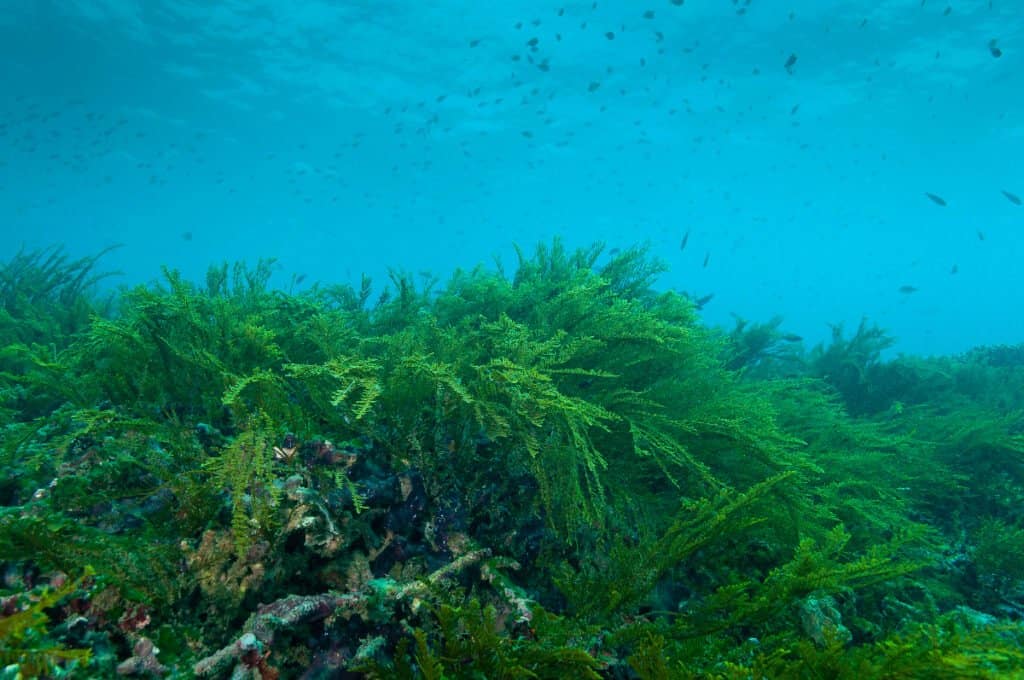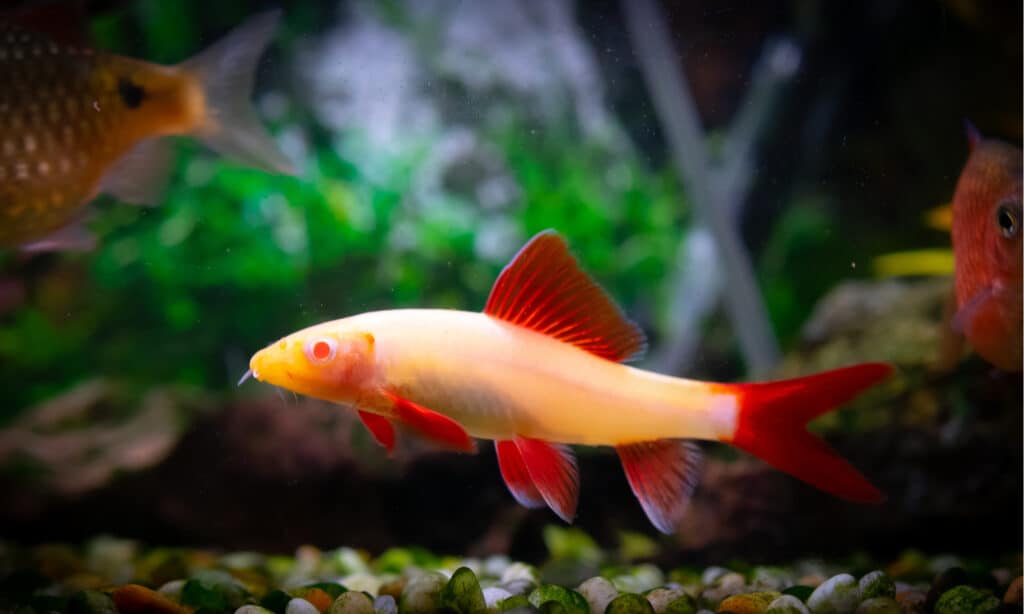
Rainbow sharks aren’t sharks at all, but freshwater fish.
©Roberto Dani/Shutterstock.com
Excited to learn about what rainbow sharks eat? It might be surprising to learn that rainbow sharks aren’t sharks at all but tropical fish. That’s correct, it’s a misnomer.
A misnomer is when a name doesn’t match what it describes. They can be amusing because when it comes to animals, they can challenge expectations.
Rainbow sharks do not have sharp teeth, do not swim in the characteristic shark fashion, and do not hunt for prey. They are not too gray, and they do not have a fin sticking up from their backs.
Thus, what is a rainbow shark, and what is so interesting about them?
The rainbow shark is a beautiful fish known for its ability to jump, and often it’s joked that they are suicidal because they can leap out of an uncovered aquarium. In an article from Princeton’s journal The Tortoise, it’s stated that they don’t make a conscious decision to jump; it’s instinctive.
So now we know that a rainbow shark is not a shark or casual predator, let’s dive in and explore a little more about them, their lives, and their diet.
Where Do Rainbow Sharks Live?

Rainbow sharks are native to the Indochina basins.
©Curioso.Photography/Shutterstock.com
The rainbow shark is a Southeast Asian freshwater fish that makes its home in the basins of Indochina. This includes the freshwater rivers of mainland China along with Laos and Thailand.
When in the wild, the rainbow shark lives at the bottom of the river, in the silty substrate that coats the base, hence they can remain camouflaged.
They are popular pets and if they don’t have enough water, they leap from the aquarium.
What Do Rainbow Sharks Look Like?

Rainbow sharks are dark blue with red fins edged in black stripes.
©Arunee Rodloy/Shutterstock.com
The rainbow shark, also known as the ruby shark or rainbow shark minnow, is aggressive as a pet.
They have a long thin body of the color indigo, with ruby red fins often trimmed in dark blue or black. As is common in marine life, the males have more colorful hues. They lose color when stressed and can be semi-aggressive if their home is too small or other fish bother it.
A male rainbow shark grows to a minimum of 10 cm and up to 15 cm long, or 6 inches in length. The rainbow shark minnow is not a large species, but it has a huge personality.
What Do Rainbow Sharks Eat?

Rainbow sharks are not picky eaters. When available, they eat algae, plankton, decaying plants, and
insect
larvae.
©Jesus Cobaleda/Shutterstock.com
Now, let’s discover what rainbow sharks dig their -er- teeth into. If they had teeth, that is.
Since the rainbow shark minnow is a typical tank fish, we will discuss nourishment: their diet in the wild and their diet in captivity.
Their diet in the wild consists of what they scavenge, which includes algae and plankton since they skim the bottom of waterways. They also grub on other decaying plants and animals for nutrients. They may also consume insects and insect larvae. If the rainbow shark comes across it, it will eat it. Rainbow sharks are not picky.
While in captivity, they are high-maintenance.
Their diet includes:
- Algae tablets or flakes
- Crustaceans
- Insects
- Larvae
- Lettuce
- Phytoplankton
- Spinach
- Worms
- Zooplankton
This is because fish owners tire of feeding the same fish flakes every day.
A diverse array of fish may often be kept by enthusiasts. This means more variety since not all fish consume the same.
Why Do Rainbow Sharks Jump?

Rainbow sharks jump for no known reason; it is thought when their enclosures are too small.
©FoxPix1/Shutterstock.com
The adult rainbow shark needs a minimum of 55 gallons, or they will harass other fish because they consider it their territory.
As an aggressive fish, when enclosed, the rainbow shark often headbutts and bites other fish along with jumping out of their tank. The small space may trigger their fight or flight reflex and they choose both.
Alas, it is unknown why the rainbow shark leaps. Are they doing it on purpose? Even science can’t say.
This discourse can often happen. Are we meant to accept that sometimes while researching or owning animals, they will just die, and we can do nothing about it?
Is there a moral obligation not to own or keep certain species of animals because they don’t survive? Of course, the answer is yes, but where is the line drawn? These are the questions posed in The Jumpers by Elizabeth Heppenheimer, mentioned earlier.
Such earnest questions need to be considered when discussing something like a small fish. We live on a planet overrun with creatures we cannot even begin to understand.
The least we can do is consider the lives we affect.
Up Next
The photo featured at the top of this post is © FoxPix1/Shutterstock.com
FAQs (Frequently Asked Questions)
Is a Rainbow Shark a "real" shark?
It might be surprising to learn that rainbow sharks aren’t sharks at all but tropical fish. That’s correct, it’s a misnomer. A misnomer is when a name doesn’t match what it describes. They can be amusing because when it comes to animals, they can challenge expectations.
Where do Rainbow Sharks live?
The rainbow shark is a Southeast Asian freshwater fish that makes its home in the basins of Indochina. This includes the freshwater rivers of mainland China along with Laos and Thailand.
What is a Rainbow Shark's diet in the wild versus captivity?
Their diet in the wild consists of what they scavenge, which includes algae and plankton since they skim the bottom of waterways. They also grub on other decaying plants and animals for nutrients. They may also consume insects and insect larvae. If the rainbow shark comes across it, it will eat it. Rainbow sharks are not picky. While in captivity, they are high-maintenance.
Their diet includes:
- Algae tablets or flakes
- Crustaceans
- Insects
- Larvae
- Lettuce
- Phytoplankton
- Spinach
- Worms
- Zooplankton
This is because fish owners tire of feeding the same fish flakes every day.
Thank you for reading! Have some feedback for us? Contact the AZ Animals editorial team.






